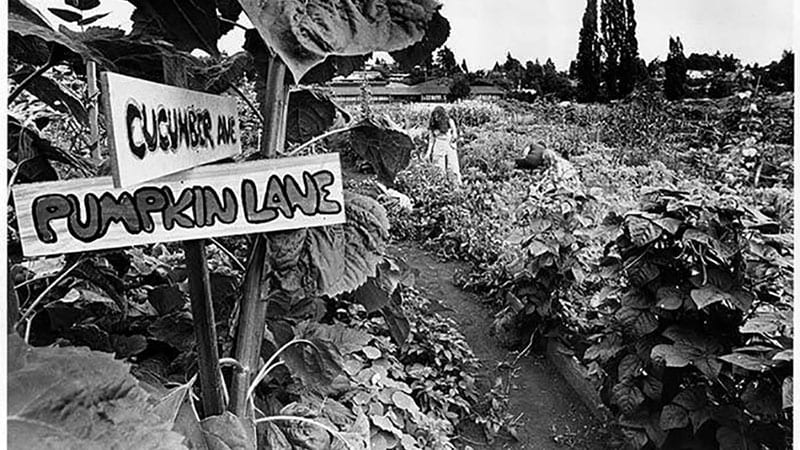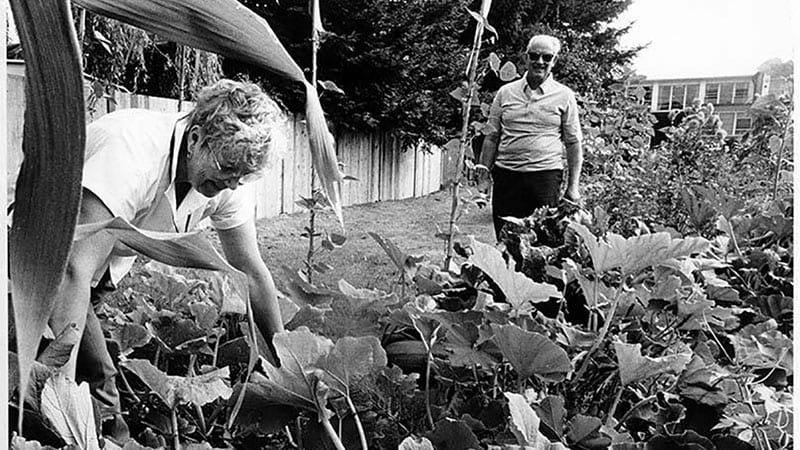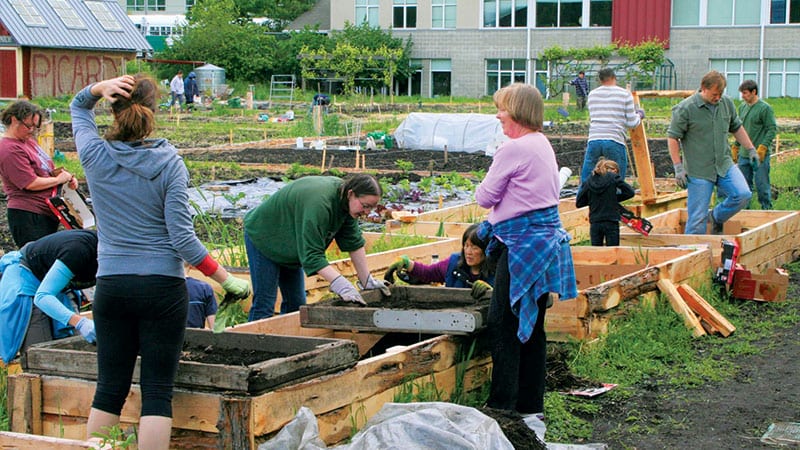Planting a legacy: Seattle’s P-Patch gardens
By Rebekah Denn
This article was originally published in May 2020

It wasn’t a big announcement in March of 1973, just a handwritten headline in PCC’s mimeographed newsletter that read “COMMUNITY GARDEN.”
Wedged near a recipe for banana-yogurt-wheat-germ smoothies was a short proposal that PCC temporarily manage some public garden plots on the “old truck garden land near the store” that was threatened by development.
“That would save it from Suburbia and preserve it for community gardening in the future,” wrote Randy Lee, PCC’s manager at the time and longtime chief financial officer.
No one then could have guessed the agreement between the city, the co-op and a retired Wedgwood farmer would lead to Seattle’s P-Patch program (the “P” was in honor of Rainie Picardo, the farmer), one of the largest and most honored community gardening initiatives in the nation.
Dozens of the garden oases are now scattered around the city, patches of vegetables, fruits and flowers that nourish neighborhoods while creating vibrant connections between neighbors. The city helps establish, administer and manage the sites, including providing water and organic fertilizer, and many garden startup costs are paid through the Department of Neighborhood’s Neighborhood Matching Funds. (Some are also supported by nonprofit partnerships.) Gardeners agree to farm organically, to pay annual fees that range from $47 to $92 (though financial assistance is available) to keep the site open to the public, and to contribute a minimum of eight hours of volunteer time to maintain the patch’s common areas.
More than 3,100 gardeners currently tend plots at 89 P-Patch gardens around Seattle, according to the most recent figures from Seattle’s Department of Neighborhoods. Options range from the tiny Ida Mia garden, seven plots tucked into a Madison Valley alley, to a partnership with the 7-acre permaculture project known as the Beacon Food Forest.
The gardens are not keeping pace with Seattle’s soaring growth, though. An impressive flurry of P-Patches were funded through the 2008 Parks and Green Spaces Levy—money allocated for four new sites was stretched to support 28 new or expanded gardens—but only one has been added since 2013, even as the city’s population has increased by around 20%. There are no current plans to seek out new land for gardens or add the city staff required for significant expansions. P-Patch waiting lists range from three months to four years, depending on the site.
As the population skyrockets, land prices soar, and human services are strained to the breaking point, some worry the gardens will succumb to the same pressures as other Seattle landmarks and refuges of open space.
Gardeners at the Ballard P-Patch, which has occupied a half-acre site for 43 years, had a longtime agreement to rent the land for $1/year from the owners, Our Redeemer’s Lutheran Church. But the parcel—one of the largest pieces of undeveloped land remaining in Ballard—is being sold to raise money for needed church renovations. The gardeners are trying to swiftly raise $2 million to buy the land and maintain its 94 plots, massive donations to local food banks and weekly community potlucks. Gardeners have an agreement to buy the site, but the deal is contingent on raising the money. Otherwise, the land is zoned to support construction of four single-family homes.
The 25,000-square-foot UpGarden P-Patch on the top level of the Mercer Street Garage, an innovative use of urban space, received an eviction notice last year to make room for more parking. After community protests, it won a six year reprieve.
The nonprofit GROW Northwest organization, which owns or co-owns six P-Patches, has identified six additional patches throughout the city that could be lost because they are on private land. While other patches on city land are relatively stable, there is no guarantee. “[A]s we saw with the UpGarden at Seattle Center, a garden can be taken away if the city needs/wants the land for other uses,” director Joyce Moty said in an email.
The gardens experience internal and outside pressures as well, from amassing the “people power” necessary to making the programs work to dealing with conflicts or people misusing the space.
“Each garden has its own issues. They are always struggling with some issues. But that’s what it’s about.
“It’s about community, and community isn’t an easy thing. It’s about how we get along with each other, how we tolerate and support and respect and learn how to communicate with each other,” said Julie Bryan, community garden coordinator for Seattle’s Department of Neighborhoods.
“Urban open space is a lot different than your private space. It’s also very rewarding.”
Despite all the changes in the program, that’s been true since the very beginning.

“That soil is so fine”
That first P-Patch came alive through the work of Darlyn Rundberg (later Del Boca), a University of Washington graduate student and PCC member. She lived near the former Ravenna PCC, the co-op’s only store at the time, and near Rainie Picardo’s land.
The Picardo family had settled in Wedgwood in the 1920s, according to a 1994 P-Patch cookbook (“The City Gardener’s Cookbook”), buying 20 acres for a truck farm that originally stretched from 25th Avenue NE to 35th Avenue NE and from Northeast 75th Street to Northeast 82nd. The family harvested the “wonderfully productive” rich black soil daily, the history said, hauling carrots, lettuce, celery, onions and other crops down to sell at Pike Place Market.
By the late 1960s, Picardo had retired and owned only a few remaining acres of the farm. Rundberg persuaded him to let her plant a garden with neighboring schoolchildren over the next few years to connect them with nature and give their families an affordable source of good food.
“It was kind of the time of ‘back to the land,’ said Koko Hammermeister, who worked for PCC in those years. The country was in an economic slump and struggling with the Vietnam War. The influential Whole Earth Catalog had been published and a growing movement of young people were learning about sustainability and self-sufficiency. In Seattle, the Boeing Bust hit hard, with rising unemployment and newly established food banks. Rundberg’s children’s garden supported Neighbors in Need, an early food assistance program, as well as providing vegetables for gardening families.
After a few seasons, though, the taxes on the land became too much for Picardo. The property seemed doomed to development. But “Darlyn had a really great idea and she ran with it,” Hammermeister recalled.
What if the city of Seattle could lease the land for the $688.23 due in taxes and a few miscellaneous costs? What if PCC would agree to administer community garden plots where no chemical pesticides or fertilizers were allowed, with priority given to lower-income residents?
From PCC’s standpoint, supporting the concept was a “no-brainer” recalled Lee, who retired from PCC in 2018. The idea tied in with the co-op’s support for fresh, local and organic produce, while many gardeners were among the membership.
“It was the organizational endorsement and commitment to run the project that [Rundberg] needed from PCC when she first approached us,” said Lee. It was a strategic move for a pilot project—“code-named P-Patch,” as The Seattle Times put it in 1973. Bringing in an institution like PCC “(small storefront that we were at that time)” to handle the administrative work would improve Rundberg’s chances for city support, eventually protecting the land long term.
Rundberg’s request didn’t seem like a significant commitment of time or money, Lee said, and “everyone—board, staff and members—loved that we were involved in helping make it happen.”
Every one of roughly 200 plots filled that first season in 1973, including a “ghost gardener” on the books who turned out to be Picardo himself.
Newspaper accounts at the time showed volunteers dug a 300-foot-long, 2-foot-deep trench for a city-installed water line, while families from babies to grandmothers filled the garden to prepare the land and plant their first seeds.
PCC asked Hammermeister, who had been looking for more work hours after dropping out of law school, to take on the administration.
“I grew up in the Puyallup Valley and had worked for the Washington State Extension Service. My parents lived on practically an acre and had 250 blueberry bushes…
“We had lots of fruit trees and a huge vegetable garden. Actually, quite frankly, in (1973) I probably would have looked on doing a lot of gardening as being more burdensome. But this sounded fun, because there were a lot of people involved.”
She collected the small plot fees, helped shovel in soil amendments, linked gardeners with resources and addressed occasional nuisances like meter maintenance and “vegetable vandalism,” as a PCC newsletter put it. Then, she and Rundberg watched the crops grow: Sunflowers, edible greens, peas and beans and beets and squash, bushels of potatoes, baskets of tomatoes.
At season’s end, Seattle Mayor Wes Uhlman, along with P-Patch champion and City Councilman John Miller, came out with other politicians for a harvest feast.
“WE DONE GOOD!” Hammermeister wrote in PCC’s newsletter, the predecessor to the Sound Consumer. She gloated at the mayor requesting more corn on the cob, predicting the warm reception would improve the chances of preserving the land in perpetuity.
“Oh, how painful to sacrifice that wonderful corn…but, it will be worth every kernel!”
PCC members were asked to write the mayor and the city, asking that the city purchase and preserve the land. (“Be sure to mention ‘organic’ on your card!”)
As the proposals worked their way through the system in 1974, Rundberg applauded how “THAT SOIL IS SO FINE.” She thanked Picardo for “so generously and sympathetically” allowing public use of his land, and shared her fears that (then, as now) “the demand for soccer fields and ball diamonds is great” and the land, conveniently near Dahl playfield, might be converted to new sports facilities.
“I hope the Patch has proven itself to the community and that the community will guard its agricultural use, whether the City buys it or not.”
Enthusiastic supporters backed preservation, including columnists at The Seattle Times, whose staff had gardened at Picardo.
“How did such a complex program of agricultural coordination and volunteer labor work so well when it was in the hands of a handful of hippies?” wrote John Hinterberger, who later became the paper’s influential restaurant critic.
“And since it did—casually, brilliantly—should we run Koko Hammermeister for City Council?”

Past and future
Ultimately, despite some debate, the city purchased the land from Picardo and took over the administration from PCC.
Robert Cahn, then a zoology professor at the University of Washington, tested the soil in the P-Patch and saw its preservation as a unique opportunity: “To have a piece of prime agricultural land left in the center of a modern city is indeed a marvelous and highly extraordinary situation…” he wrote the City Council.
He imagined the Picardo patch sparking others citywide, encouraging community composting and even food sharing—all of which it did. Cahn imagined it “could be a force for neighborhood involvement, which would strengthen our city as no other city has been—we would be “much more together” and able to cope with the coming environmental crises of the next decades.”
The program scaled up almost immediately, quickly reaching 10 sites under the stewardship of Edith Walden, who later become a farmer herself on Guemes Island, credited with bringing local quince to the region’s markets.
By 1974, The Seattle Post-Intelligencer already referred to the P-Patches as a national model. Councilman Miller sent an invitation to President Ford to visit the Picardo patch on a 1975 visit to Seattle, citing it as an example of American self-sufficiency. The program won major gardening awards.
City questionnaires from Patch participants in those early years showed they dealt with the same issues as modern-day Seattle gardeners—slugs, slow-ripening tomatoes, excessive quantities of zucchini. They reaped some of the same rewards, too.
In paperwork from 1975, Joyce Lehde and Lyle Sellards estimated they grew $236.36 worth of produce on their patch, from chard and celery to acorn squash and “spuds.” And they wrote in something just as precious: “We used P-Patch mint leaves in our bouquets at our wedding.”
Another 1975 gardener’s reward came from watching his 12-year-old and 9-year-old, “City Kids,” at work: “They plant, care for, watch grow, and work a garden that will eventually put food on their own table. It’s an unusual and beautiful experience for them. I hope that they will hold as many fond memories of “the patch” as I do the garden of my childhood.”
By 1990, one user wrote that “In this city which is growing too fast, more and more people are living in dehumanizing rental units. P-Patch helps me retain my sanity.” Another saw that “Amidst all the urban insanity and global warmongering over resources I get a small sense of self-sufficiency.”
The program had expanded to 39 sites by 1999—but patches came and went. A 1980 overview of the program by Seattle’s Department of Human Resources noted that projects in the Seattle City Light right-of-way “are the only spaces which are unlikely to be developed; all other land is subject to change.”
City records contain years of rental agreements signed with individual landowners, as well as notices that patches are being evicted or relocated.
Some 180 gardeners were displaced when the expanding Arboretum replaced a Montlake P-Patch with a stand of pine trees, leading one participant to write in 1979, “I am a very sad gardener…Please do not turn us out.” (The area, known then as “the pit,” became a P-Patch after plans for the R.H. Thomson Expressway were abandoned.) The expansion of Children’s Hospital eliminated another patch in 1977, while community pressure and an ugly culture clash led the city to shut down a Beacon Hill garden in 1983 that had been developed for low-income refugees from Southeast Asia.
The owner of what was known as the Hillside patch in Ravenna wrote in 1988 that she could not renew the lease, as her husband had died and “I can’t afford to pay the taxes they have gone so high, so I am going to sell the property… I’m sorry to see the Pea Patch go.”
Beyond those patchwork gains and losses, the program became fundamentally endangered in the 1980s, when Seattle budget cuts restricted services like rototilling and many plots went vacant, according to the cookbook and news accounts at the time. With the help of an advisory council and later a land trust, gardeners obtained grants and made other connections to strengthen the program. When land for the Pinehurst Garden was donated to the advisory council in 1987, according to a Department of Neighborhoods history, it gave P-Patches more credibility “as a legitimate land use” and diminished the sense that the gardens were only meant as interim uses.
A changing city
As Seattle’s open land shrinks and its needs grow, we might look to P-Patches to be part of the solution rather than a victim of those pressures.
In recent decades, P-Patch administrators have actively tried to reflect the needs of different city constituents, adding options like educational youth gardens and “market gardens” whose produce can be sold, as well as prioritizing gardens serving low-income and underrepresented populations.
For future P-Patch projects, goals include building on the department’s partnership with the Seattle Housing Authority, serving denser neighborhoods with even less access to open space.
Finding a large enough patch of land isn’t the only roadblock. A garden needs enough sun and the right soil, and can’t interfere with environmentally critical areas. If the property is privately owned, the owner must commit to at least a five-year P-Patch lease, which can’t cost much (if anything). Then comes organizing and designing, and conversations with neighbors, and the ongoing work that—in a successful P-Patch—will really never end.
“That’s always how places have come into being, from the ground up,” Bryan said.
A quarter of P-Patch gardeners said in a recent city survey that they worried or stressed about having enough money to pay for food in the past 12 months. More than three-quarters had no space for growing food at their residence, 40% had gross household incomes under $60,000, and 27% represented communities of color. The city provided financial help to 571 families to afford the plots in 2018, and 54 of the gardens have gleaning programs or a “giving garden” plot for food banks, contributing literally tons of fresh produce—and much more.
They’ve been spots for unique projects, like a composting toilet at the Picardo site and rainwater harvesting cisterns. Interbay Patchers, well known for their enthusiastic composting program, composted flowers contributed to local vigils after the September 11, 2001 terrorist attacks, then brought a bag of the compost to a community garden near the World Trade Center along with their good wishes for renewal.
“It can be a place for innovation, and a place to try things out on a small scale that shows that they can be done,” Bryan said.
For Hammermeister, who gardens at her own Seattle home, the P-Patches around the city are always places to admire and appreciate.
“(Rundberg) could see that Seattle was growing, and that land might not be kept in food production. She worked pretty tirelessly for the cause, and she was quite successful,” she said.
“I look back with gratitude for having been able to participate like that.”
Join a waiting list for a P-Patch plot here.
You can contribute to the Ballard P-Patch purchase fund at mightycause.com.
